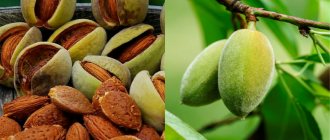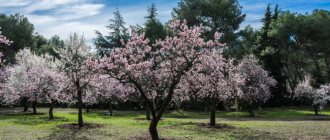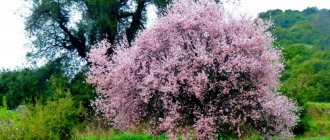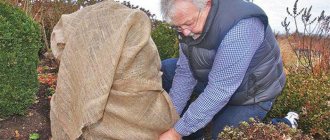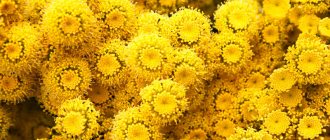Many people think of steppe almonds as a delicate, heat-loving plant that can be destroyed by even a little cold. However, this is not quite true. Almost all types of almonds can withstand fairly low temperatures (down to -25), and bush almonds can survive -40 without any problems if they are kept warm in the spring (cold temperatures are destructive for the inflorescences, flowers and petals themselves).
Therefore, those who want to grow almonds in our country have good news for you: a type of almond that is resistant to winter has long been known in breeding and can take root even closer to the North: there are practically no restrictions for growing this type of almond.
What you should know
This almond has several names:
- steppe almonds;
- almonds low;
- almond bean.
Low almonds have been known to science for several centuries. But only thanks to the famous breeder I.V. Michurin managed to create winter-hardy varieties of almonds and peaches based on the bean plant.
For wild almonds, just from its name you can figure out the habitat area - first of all, these are steppes and forest-steppes. Today, the number of wild almonds is rapidly decreasing. At the same time, this shrub is not found so often in gardens. Outwardly, it is inferior to its decorative counterparts, however, the ability to tolerate very low temperatures is a big plus when choosing this particular type of almond for planting on your site.
Thanks to the efforts of gardeners who are passionate about the selection and propagation of this type of almond, the bean plant has every chance to become a full-fledged resident of northern gardens. After all, almond bean is a beautiful and hardy shrub that can make any garden even more beautiful and mysterious, more incredible and truly different from everyone else’s.
What does wild almond look like?
Wild almond is a shrub reaching one and a half meters in height, the branches of which are straight and spreading, covered with a large number of short branches. These branches form a lush crown, shaped like an egg or a ball. The branch of the steppe almond is decorated with brown bark (sometimes reddish-gray).
Unlike its strong and tall counterparts, the bean plant has a loose root system; its roots break easily. The leaves of the shrub are lanceolate, about 7 centimeters long and no more than 3 centimeters wide. The edges of the leaves are serrated, pointed towards the apex, leathery and have a characteristic shine. The top of the leaves is much darker than the bottom.
Flowers
However, the main pride of wild almonds is its flowers, which bloom simultaneously with the leaves in May. The diameter of bean flowers does not exceed three centimeters, but in beauty they are in no way inferior to decorative almonds; for example, we can take the “pink foam” type for comparison. The blooming steppe almond in the photo looks very beautiful and touching: its fragile branches are covered with a delicate cloud of pink petals.
The flowering of steppe almonds is short-lived – it lasts about a week and a half. Wild almonds are very loved by bees, like other types of almonds they are a wonderful honey plant.
The wild shrub is very beautiful, which is why breeders have developed many varieties of this type of almond. The names speak for themselves:
- Pink Mist;
- Pink flamingo;
- Dream;
- gentle Anyuta.
Are wild almonds edible?
The fruits of the steppe almonds are somewhat similar to bitter almonds. As you know, ordinary almonds are sweet and bitter:
- Sweetish almonds are familiar nuts that can be eaten without any processing.
- The situation with bitter is different - its nucleoli contain a dangerous substance - amygdalin, which is poisonous without special heat treatment.
Wild bean kernels also contain this substance, so consuming it raw is extremely dangerous. However, once processed, wild almond seeds become a suitable spice for poultry, meat or rice. The fruits of wild almonds do not exceed two centimeters in length and are a dry, ovoid drupe with a light, velvety pericarp.
Gardeners - important points for them
Fruit ripening occurs in September. They contain almost 50% healthy vegetable oil, often used as a substitute for almond oil.
Since ancient times, almond kernels have been used in various areas of human life: in cooking and for the manufacture of medicines and cosmetics.
In medicinal applications, almonds are used in the form of drops, decoction or simply nuts. Drops help to restore normal heart rhythm or as an expectorant for diseases of the lungs and throat. Nuts with milk help overcome a severe cough, and drops are suitable for earaches and headaches.
Diseases and pests
- Aphids are a pest that feed on greenery and infect shrubs with various diseases. The insect reproduces quickly, so measures against it must be taken immediately. Infusions made from dandelion or potato tops are excellent against aphids.
- Gray rot is a fungal disease that appears as brown spots on the leaves. After rain, the spots become covered with a white coating - a cloud of spores, which the wind quickly spreads throughout the garden and infects other trees on the site. Fungicides, which can be purchased at specialized stores for gardeners, help against the disease.
- Clusterosporiasis. The disease activates and spreads faster in wet weather, and its symptoms are numerous spots on the leaves and fruits. Fungicidal preparations help to cope with clasterosporiasis.
Preventive measures will protect almonds from death: spraying with Bordeaux mixture and pruning. The main cause of diseases is improper cultivation.
Excessive watering provokes the development of fungal diseases, so shrubs should not be watered too often. Spots, wilted leaves and other external symptoms may not indicate a lack of nutrients in the soil.
Basic rules for the disease: pruning and destroying affected branches, digging up the area, cleaning up last year's foliage in which pests could be hiding.
Growing wild almonds in your garden
Wild almond is an unpretentious plant that can easily reproduce due to the large number of root suckers. Reproduction options include grafting, layering and seeds. It practically does not propagate by cuttings.
Planting and caring for bean almonds does not require the gardener to have much knowledge in breeding and plant growing. Almond seeds are sown closer to winter, and fruiting after seed planting begins no earlier than five years later.
If almonds are planted by layering or suckers, then they will bear fruit in the third year. With successful selection of almond forms with fruits that do not have bitterness, this shrub can become a good fruit-bearing crop.
Reproduction
The bean tree reproduces both by seed and by vegetative means. All methods are quite effective.
From the bone
To use a seed to produce a new plant, you need to wait until the seeds ripen, then collect them and be sure to stratify them within 60 days. To do this, they must be immersed in moistened sand and kept at medium temperature. Then the seeds are planted in a sand-peat mixture under a greenhouse at a temperature of +18...+20°C and a humidity of 45–50%. After 2-3 months, future nuts will begin to grow. When they get a little stronger, you can take them out into the open air for hardening. Next year, seedlings are being planted in a permanent place.
Almond grafting
The rootstock can be any type of almond, but it is advisable to give preference to frost-resistant ones. It takes root well on cherry plum, bird cherry, blackthorn, and plum. The rootstock should be chosen straight, with developed stems and eyes on them . The cuttings need to be cleared of foliage, leaving only short petioles of a centimeter in length.
If everything is done correctly, after 15 days the petiole will fall off the bud. Then you should loosen the fixation. With the arrival of spring, the root collar is freed from the soil that was covered in the autumn, and the tape is removed.
Cuttings
Petioles are harvested from mid to late June. A semi-lignified shoot tip with two nodes is selected and cut off to obtain a 15–20 cm petiole. For a day he is immersed in a growth stimulant. For rooting, place in a cold greenhouse. Planted in a soil mixture of peat and sand in a ratio of 2 to 1. The rooting process takes 20–30 days. Typically, 85–100% of the petioles survive this period safely and can be transplanted to the garden bed for growing.
Overgrowth
To use root suckers for propagation, you need to find the most developed bush and in the spring separate from it a part of the root that has a dormant bud or a formed young shoot. The cut area must be treated with charcoal. The new plant is planted in a permanent place in a pre-prepared hole.
By layering
To propagate by layering, you need to choose a flexible and long shoot. Where it will come into contact with the ground, an incision is made and sprayed with a growth stimulant. The shoot bent to the soil is buried to a depth of 10 cm. After two years, the new plant can be separated from the mother bush and planted in a permanent place.
Although low-growing almonds cannot be used for food, they can be used to decorate your plot and strengthen the slopes. The plant is unpretentious and grows calmly even in arid climates. Therefore, it does not cause unnecessary trouble in care.
How to properly care for beans
Steppe almonds do not create any trouble for the gardener, which is why they have long been loved by gardeners. It is unpretentious to sudden changes in temperature, can easily withstand both the hottest and coldest temperatures, even smoke is not scary for it. Once trimmed, wild almonds just begin to grow even better. In general, it is better to cut it off as often as possible and not run it.
The shrub is not too demanding of both the soil and its fertile abilities; insects and diseases, unlike the delicate “pink foam”, are practically not afraid of it. But it’s worth feeding the soil a little with special fertilizers only for yield purposes. If you do all the work on time, the harvest will be lush.
According to the recommendations of experts, the steppe almond bush is pruned in the spring, after flowering has ended. Pruning involves shortening the size of the branch by approximately 1/3. Thanks to pruning, many young shoots are formed on the branch, which then form buds - next year they will turn into flowers.
Planting a nut
Planting shrubs is not a complicated process. The main thing is to choose the right place for it.
When to plant
It is recommended to start planting work in the autumn, after the leaves have fallen. You can also plant in spring, when the threat of night frosts has passed and the weather has become consistently warm. But still, if possible, preference should be given to autumn planting so that the shrub begins to grow earlier.
Video: planting almonds
Landing place
Low almond thrives in open areas. He loves well-lit southern areas of the garden. Of course, if it is not possible to allocate a sunny bed for the plant, then it will grow well in the shade, but it will not bloom so profusely. The shrub is not picky about the composition of the soil, but it reacts to acidity. It needs neutral soils with a pH of 4.5–7.5. Groundwater should not come close to the surface of the earth. If possible, preference should be given to sandstones or loams.
Important! The bean plant requires cross-pollination, so it must be planted in more than one bush. Ideally: if there is a small apiary near the planting.
Preparation of seedlings
Steppe almond seedlings do not need special preparation. Before planting in the autumn, you only need to disinfect the roots with a weak solution of potassium permanganate. If planting is in spring, then it needs to be treated with a clay mash. Such manipulations make it possible to retain moisture in the plant so that it does not dry out while it takes root.
Planting process
The hole is dug at least 0.3 m deep. A gap of 3–5 meters should be left between the bushes, and about 5 m between the rows. The bottom of the planting hole is lined with drainage (crushed stone or broken brick). Sand is poured on top. A stake is driven into the middle of the hole and a seedling is tied to it. The stake should be of such a height that it rises at least half a meter above the surface.
It is advisable to plant in the morning or after 4 pm. The seedling is carefully lowered into the hole and covered with soil mixture (top nutrient soil, sand and humus). The root collar should be left above the ground. There should be a small distance between it and the soil. At the end, the bed is mulched with peat or dry soil.
Characteristic
The main feature of wild almonds is the rapid death of old shoots and their displacement by young ones. As a result, the almond bush grows very quickly. Knowing this fact, gardeners remove old trunks, which will then make room for new young growth.
The wild almond bush, beautifully designed and compact, attracts attention in any garden and adds zest to the design. Even without flowering, it looks like a spectacular decorative decoration for a garden plot. It will fit especially well into an alpine hill, but even with single plantings, the wild almond bush looks charming in photos and in real life.
It is worth noting the fact that only proper care can lead to good productivity. In addition, steppe almonds are also called dwarf almonds because they are not too huge in size. Why did we give an example and compare steppe with pink? Everything is quite simple, this steppe belongs to the pink almond family. Thanks to proper care, this particular type of product still has the slightest chance of settling in our country - which, naturally, is the main advantage.
Features of care
Bobovnik is a southern plant and, despite its unpretentiousness, requires attention and compliance with certain rules of care. Neglecting the recommendations can lead to plant disease or even death. A distinctive feature of almonds is the ability to actively produce shoots, so the main rule of care is to remove them in a timely manner. Otherwise, such growth leads to weakening and less abundant flowering of the bush.
In early spring, pruning of the plant is mandatory. This procedure is carried out in order to create the correct crown shape for the bush and remove diseased and dried branches. Pruning the plant promotes the formation of a more luxuriant crown of the bush and its abundant flowering. This procedure is carried out immediately after flowering. Each branch of an adult bush is cut to about a third of its length. For its ability to tolerate pruning well, the plant is in great demand among landscape designers.
